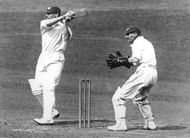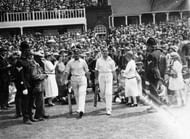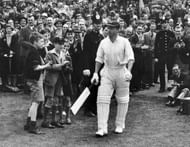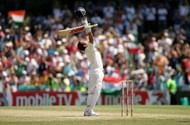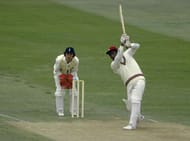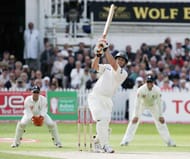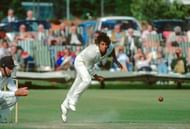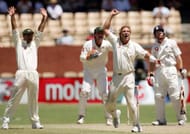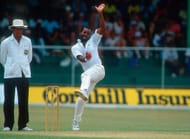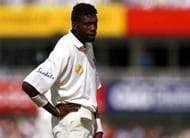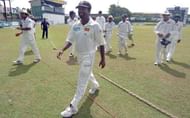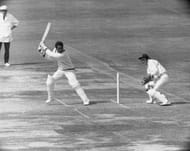One of the most enjoyable aspects of Test cricket actually happens prior to the part where the action unravels. The fervent anticipation in the air when a bowler is in the midst of a surging spell or when a batsman prepares to be in the zone has to be first preceded by the hard grind.
However, the satisfaction that follows it gets entrenched in our memories forever. Cricket in its original and purest sense offers emotion that cannot be replicated by anything else in the sport. So, here we are – 2220 Tests and counting.
Also Read: An All time Indian XI vs Australian XI
Selecting a world XI from innumerable players spawning various generations seems to be an almost insurmountable task. But, as they often say, the very fabric of Test cricket is one of perseverance and tenacity.
Here are some of the factors which have been taken into account before honing in on the masters of the game.
- Unlike the other two formats, Test matches cannot be won unless the opponents are bowled out twice. Hence, the presence of five quality bowling options cannot be compromised when competing on different conditions across the globe.
- Possessing a balanced home and away record helps us judge a player’s versatility as well as dependability.
- In order to normalize statistics from distinctive eras, the strength of each team becomes extremely important as also the prevailing trends.
- Performing under difficult circumstances against world-class players help decide between similar numbers.
- Peer appreciation is considered to be another valid criteria to tilt the scales in a player’s favor.
We, at Sportskeeda, bring you a team which has most bases covered and can stamp their authority on a broad spectrum of pitches ranging from a green top in Headingley or a classic ‘Madras’ square turner to the WACA at its quickest or the modern-day soul-sapping UAE featherbeds.
#1 – Sir Jack Hobbs (England)
Aided by an insatiable appetite for runs, John Berry ‘Jack’ Hobbs lorded over first-class cricket if his tally of 61760 from a whopping 834 matches is anything to go by. Despite losing almost six of his prime years to the ‘Great War’, he did not mind the international stage either with his record at the highest level monumental enough to result in him becoming the inaugural professional to receive the knighthood.
Legendary cricket writer John Arlott described Hobbs as a predominantly bottom-handed batsman who did not operate as per conventional norms. Astonishingly, his first 11, as well as, final six Tests did not see him cross three figures even once.
But, he more than made up for it by achieving 15 of those during a 12-year peak which fetched him 4261 runs from 44 matches at an imposing average of 65.55. When father time was threatening to play catch up, a reinvigorated approach labeled his prowess as the game’s oldest century-maker.
Did You Know – Hobbs was the first batsman to score over a thousand runs at a venue away from home – 1178 to be precise which came at MCG.
Statistics: 5410 runs from 61 matches at an average of 56.94 with 15 centuries and 28 fifties.
#2 – Herbert Sutcliffe (England)
If Hobbs was at one end, then who else apart from Herbert Sutcliffe at the other? Forming one-half of the most storied opening partnership of all-time, the right-hander dug deep into a seemingly unending reservoir of concentration to thwart the era’s threatening bowlers with plenty of his iconic knocks coming on sticky wickets which had consumed numerous other accomplished batsmen.
Among those who have scored at least 4000 runs, only a certain Australian managed to average more than Sutcliffe. Although he often blunted opposition attacks with his dour defence, the Yorkshireman could also hook the meanest of bouncers as easily as lofting the spinners which would make him a complete batsman under diverse circumstances.
A team player to the core, even the infamous ‘Bodyline’ series did not swerve his loyalty.
Did You Know – After sharing the stage with influential Scottish author Sir Compton Mackenzie during an event, Sutcliffe gushed to him, “Oh, my, how I wish I could speak like you!” to which Mackenzie replied, “You don't wish nearly as much that you could speak like me as I wish I could bat like you.”
Statistics: 4555 runs from 54 matches at an average of 60.73 with 16 centuries and 23 fifties.
#3 – Sir Donald Bradman (Australia)
Without a doubt, cricket’s most popular number from time immemorial has been 99.94. Armed with a homegrown technique emanating from batting on matted-concrete pitches, Sir Donald Bradman stood head and shoulders above any other batsman in the game’s history. A run-machine who redefined the term ‘consistency’, the decisiveness in his footwork made him utilize the crease in a pronounced manner.
In his biography written by the versatile Johnny Moyes, Bradman’s unique bat-grip has also been documented quite intricately. Favouring the cross-batted strokes, he began still at the crease only to culminate in an extravagant flourish.
Even though his dominance on wet conditions were brought under the microscope, the ease with which the accumulator shifted from attack to defence enabled him to reach peerless status.
Did You Know – In the Italian segment of the 2nd World War, the allied forces used the code ‘Bradman will be batting tomorrow’ to signal their attack on Monte Cassino.
Statistics: 6996 runs from 52 matches at an average of 99.94 with 29 centuries and 13 fifties.
#4 – Sachin Tendulkar (India)
Often bearing the expectations of a billion-plus population on his able shoulders, Sachin Tendulkar debuted at the tender age of 16 and grew in stature with every year. When he was done, there remained only a few batting records that did not belong to him. A triumph of longevity, the diminutive batsman followed the textbook approach unwaveringly and adopted a balanced stance at the crease.
An average of more than 40 in every Test-playing country showed his versatility across a variety of surfaces. When detractors were hounding him for a lackluster fourth-innings resume, Tendulkar responded with a scintillating 103* against England in Chennai during 2008 to set up a famous victory in the aftermath of the 2008 Mumbai attacks. A man for all seasons and conditions, he ended up as the game’s leading run-scorer.
Did You Know – During his childhood, Sachin once fell off a tree and his brother Ajit sent him packing to a cricket coaching class as punishment.
Statistics: 15921 runs from 200 matches at an average of 53.78 with 51 centuries and 68 fifties.
#5 – Sir Viv Richards (West Indies)
At a time when bowlers were accustomed to intimidating batsmen, the sight of a gum-chewing Viv Richards sauntering into the middle sent shivers down the spines of even the nastiest of pacers. Brutal and breathtaking in the same measure, the ‘Calypso King’ left an indelible mark on anyone who had seen him in action with his daredevilry on seemingly difficult situations.
Never afraid to resort to extravagant shots to put bowlers off their marks, the swashbuckling West Indies icon had an air of showmanship around him. Reiterating that he was capable of making a mockery of well-laid plans, Richards scored the then fastest Test century aside from tallying the most runs in a calendar year until it was finally eclipsed in 2006.
A supremely confident cricketer, his calculated stroke-play offered an insight into the captivating Caribbean culture.
Did You Know – Richards has been hailed as the only sportsman to participate in both the cricket and football World Cups. He had turned out for Antigua and Barbuda during the qualifying stages of the 1974 FIFA World Cup. However, his name does not feature in the recorded lineups even as they failed to qualify for the main tournament.
Statistics: 8540 runs from 121 matches at an average of 50.23 with 24 centuries and 45 fifties.
#6 – Adam Gilchrist (Wicket-Keeper and Vice-Captain) (Australia)
A thorough gentleman who competed hard and fair, Adam Gilchrist revolutionized the role of a wicket-keeper batsman with his exhilarating outlook and free-spirited array of shots. Entering into the limelight on the back of long-time glove man Ian Healy’s unceremonious exit, he quickly endeared himself to Australian supporters by infusing freshness as well as a renewed sense of purpose to his team.
Even though his work behind the stumps did not echo the dexterity of Healy nor the assuredness of Rod Marsh, Gilchrist gradually improved over the years and became the heart of Australia's all-conquering team of the early 2000s. A smart tactician who never shied away from sharing his opinion on field setting or bowling changes, he led them in breaching ‘The Final Frontier’ during the 2004-05 tour to India.
Did You Know – A ‘walker’ who often did not hang around for the umpire’s signal, Gilchrist revealed in his autobiography (True Colours), “I was silently accused of betraying the team. Implicitly I was made to feel selfish, as if I was walking for the sake of my own clean image, thereby making everyone else look dishonest.”
Statistics: 5570 runs from 96 matches at an average of 47.60 with 17 centuries and 26 fifties & 379 catches and 37 stumpings.
#7 – Imran Khan (Captain) (Pakistan)
Educated in Oxford and evolved from the County circuit, Imran Khan began as an unassuming medium-pacer before shaping himself into an exceptionally valuable cricketer who could be relied upon in almost every department of the game. With a strong-minded disposition and an unmatched work-ethic, he rewrote the history of Pakistan cricket by constructing a team in his own ethos.
Unlike his predecessors as well as successors, everyone became aware that Imran was in charge. He had the precise pace and skill-set to cause severe dents at the top of of the order by swinging the ball both ways. When things appeared to be meandering, the ‘Lion of Lahore’ could instigate catastrophic collapses with seething reverse while also being a tranquil presence in the batting lineup.
Did You Know – During the last 10 years of his career, Imran averaged 51.34 with the bat and 19.16 with the ball.
Statistics: 3807 runs from 88 matches at an average of 37.69 with six centuries and 18 fifties & 362 wickets at an average of 22.81 with 23 five-wicket hauls and 6 ten-wicket hauls.
#8 – Shane Warne (Australia)
Being the man who would later go onto spin webs around batsmen by getting into their heads, Shane Warne‘s debut was particularly unforgettable – but in the wrong sense. When he sent down 45 overs and conceded 150 runs with just one wicket to show, not many would have expected him to end up as the most successful leg-spinner of all-time.
However, the Victorian did all that by also becoming a crowd puller with his palpable charisma.
Keen on giving the ball a good ol’ rip, Warne triggered a revolution by largely adhering to the basics. He remained content with his impeccable control and an assortment of straighter deliveries rather than developing a lethal googly. While it seemed like the focus was starting to shift to off-field stuff, his mesmerizing spells drove home the focal point – the ‘King of Spin’ simply knew how to pick wickets.
Did You Know – When Sourav Ganguly was once treating even his half-volleys with caution, Warne pointed to Tendulkar at the other end and remarked to him, “People have come here to watch that man play his strokes, not to see you block.” Taking the bait, the left-hander danced down the track only to get stumped.
Statistics: 708 wickets from 145 matches at an average of 25.41 with 37 five-wicket hauls and 10 ten-wicket hauls.
#9 – Malcolm Marshall (West Indies)
While the other speedsters in his famed outfit towered above him with their gigantic frames, Malcolm Marshall was the most menacing of them all. Standing at around 5 feet and 11 inches, he traumatized batsmen all over with his slippery pace and unerring accuracy. One of his greatest attributes lay in cutting the ball at an angle which left them with no other choice but to play.
Despite an indifferent start to his career which yielded just 34 wickets from 12 matches at an average of 31.88, Marshall bounced back strongly with 342 wickets from his next 69 matches at an impressive average of 19.85 and an imposing strike-rate of 44.9. Be it on a dust bowl at Kanpur wherein he razed India’s top-order within a jiffy or while bowling with a plastered hand at Headingley, he was in total command.
Did You Know – Marshall was picked for the 1978/79 Indian tour mainly because the senior West Indies stars were unavailable due to Kerry Packer’s World Series Cricket and only came to know of his selection on the radio while working in a brewery.
Statistics: 376 wickets from 81 matches at an average of 20.94 with 22 five-wicket hauls and 4 ten-wicket hauls.
#10 – Sir Curtly Ambrose (West Indies)
Renowned for changing innumerable games with manic bursts, Curtly Ambrose terrorized even top-quality batsmen by turning it on without any prior indication. Not the one to give too much away once the action ended, a popular refrain of ‘Curtly talk to no man’ added to his already brooding demeanour. However, between the 22 yards, he made sure of letting his bowling do all the talking.
While quite a few of his sensational spells came on pitches which were conducive for extra bounce, Ambrose was also the master of operating on broken fifth-day surfaces by preying on the lack of it. Although his searing pace left him for good in the latter part of the 90s, the Antigua-born cricketer utilized his vast experience and a trademark nagging line to continue to prise out wickets.
Did You Know – During his childhood, Ambrose wanted to move to the USA and become a baseball player while thinking cricket was ‘too long’. However, he changed his decision at a later age and made his first-class debut at 22.
Statistics: 405 wickets from 98 matches at an average of 20.99 with 22 five-wicket hauls and 3 ten-wicket hauls.
#11 – Muttiah Muralitharan (Sri Lanka)
Test cricket’s highest wicket-taker ever, Sri Lanka’s Muttiah Muralitharan generated a great deal of mystery both on and off the field. Blessed with a supple pair of wrists, the off-spinner carried the tiny island nation’s fortunes almost single-handedly for a substantial part of his career.
Even as the controversy surrounding his bowling action never ceased to exist, he accepted bouquets as well as brickbats with a warm smile.
Rendering incomparable services to his team, Muralitharan did not mind sending down a monstrous number of overs right throughout the day. Though he had to shoulder a heavy workload, the affable character refused to flinch and instead primed his focus to ensure that the relentless in the final delivery was not too far off from the opening one with a mind-boggling 67 five-wicket hauls testifying to the fact.
Did You Know – During the 2004 tsunami which wreaked havoc on places surrounding the Indian Ocean, Muralitharan narrowly escaped nature’s fury when he arrived at Seenigama (a village near Galle) 20 minutes later than scheduled. Shaken by the destruction caused, he responded by being extensively involved in the subsequent philanthropic work.
Statistics: 800 wickets from 133 matches at an average of 22.72 with 67 five-wicket hauls and 22 ten-wicket hauls.
12th Man – Sir Garry Sobers (West Indies)
With only 11 places up for grabs, the decision to leave out Sir Garry Sobers was incredibly tough and could be ascribed to the balance of the side. A rare multi-dimensional cricketer, the left-hander could do almost anything and everything on the field. Whether it was flaying bowling attacks to all parts of the stadium or taking the new-ball or beating batsmen with drift and turn, he epitomized the term ‘all-rounder‘.
As a close-in fielder too, he could predict his radar and swoop in on half-chances instinctively. His genius arose from an unambiguous mindset of which the fiery Fred Trueman exclaimed, “He has a great cricketing brain and his thought processes are lightning quick.” A statesman who believed that the game stood above victory and defeat, Sobers was an entertainer par excellence.
Did You Know – Sobers was born with six fingers in both hands. At 10, one of those extra digits was removed with a tug and cat glut while the other finger got chopped off with a razor-sharp knife when he was 14.
Statistics: 8032 runs from 93 matches at an average of 57.78 with 26 centuries and 30 fifties & 235 wickets at an average of 34.03 with six five-wicket hauls
Full Team: Sir Jack Hobbs, Herbert Sutcliffe, Sir Donald Bradman, Sachin Tendulkar, Sir Viv Richards, Adam Gilchrist (wk & vc), Imran Khan (c), Shane Warne, Malcolm Marshall, Sir Curtly Ambrose, Muttiah Muralitharan; 12th man – Sir Garry Sobers
Brand-new app in a brand-new avatar! Download Cric Rocket for fast cricket scores, rocket flicks, super notifications and much more!
